
Chapter 4: The Maria (3/3)
|
[90] |
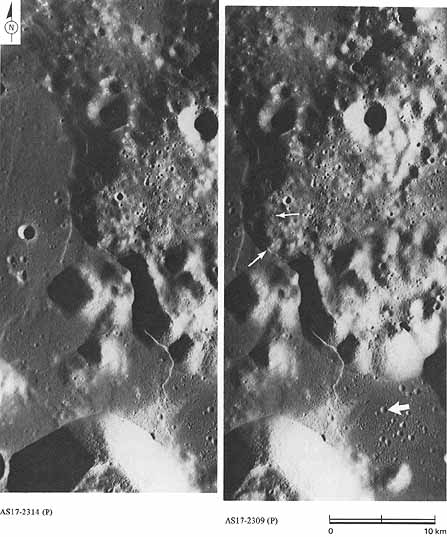 |
FIGURE 80 [above].- A stereoscopic view of the only mare ridge climbed by man. The ridge crosses the Taurus-Littrow valley shortly west of the Apollo 17 landing site (large arrow) and was traversed by astronauts Gene Cernan and Jack Schmitt in the Apollo 17 lunar roving vehicle. Geologic and topographic maps of the area appeared earlier in this chapter (figs. 61 and 62). From the valley floor the ridge extends northward into the highlands. It is offset between the two small arrows and is partly buried by dark mantling material along its northern extension. B.K.L.
[91] FIGURE 81 [below].- This enlargement provides a closeup view of part of the ridge. The fact that a fairly young impact crater (A) is deformed by the ridge and the generally fresh appearance of the ridge both suggest that it is fairly young. Within the valley, the ridge consists primarily of east-facing imbricate scarps, although west-facing lobate scarplets are also present. After crossing into the highlands (B), the ridge becomes a simple one-sided scarp resembling a fault scarp. If faulting was involved, movement was upward on the left side or, less probably, downward on the right. The Apollo 17 astronauts were unable to provide conclusive answers concerning the origin of the ridge owing to the thick cover of regolith and avalanche material. Photogeologic study indicates that part of the ridge may have formed by displacement along a fault or, less likely, by the upwelling of lava. B.K.L.
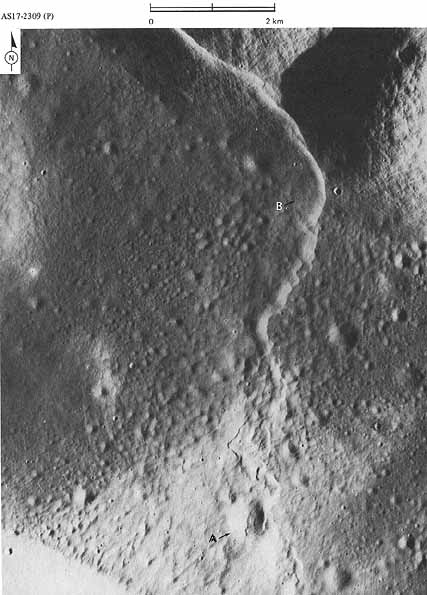
|
[92] |
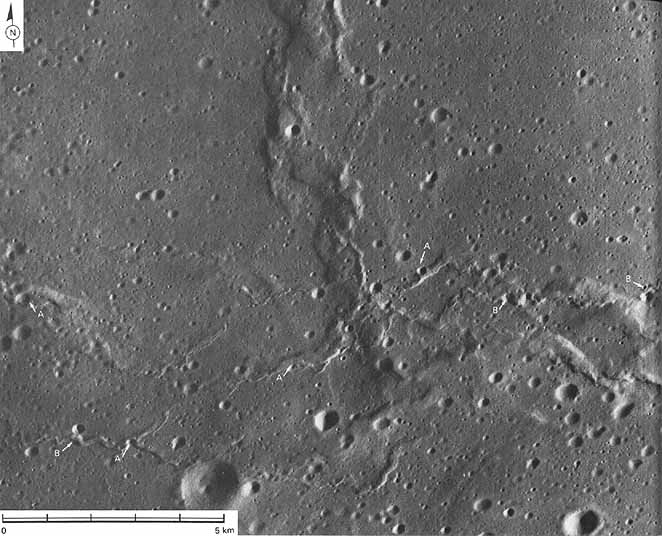 |
FIGURE 82 [above].-These intersecting sets of mare ridges are near the western edge of Mare Serenitatis. One set of generally small, sharply defined lobate scarps and ridges trends irregularly east to west. It cuts across a set of broader, more subdued ridges that trends north to south. On the basis of morphology and crosscutting relationships, the first set appears to be the younger of the two. Study of the better preserved younger set provides two clues to its origin. In several places (designated by A) incomplete craters are present on the flanks of ridges, but the other parts of the originally circular craters are absent on the adjacent mare floor. This suggests that some segments of the ridges are the frontal edges of thrust plates that have ridden over an already solidified and cratered surface. In several other places (B) craters on the mare floor appear to be partly overlapped by lobed projections of the ridges, suggesting inundation of the craters by a viscous material. The ridges in this area as in others may thus be the response of solidified rocks to faulting and possibly also to the movement of molten rocks.-B.K.L.
|
[93] FIGURE 83 [right].-The arcuate ridges shown here are part of the large crater Lambert R, which is mainly deeply buried and now outlined by mare ridges and a few isolated remnants of the original rim. This is one of many examples in which underlying topography is reflected by mare ridges, thereby suggesting a causal relationship. The ridge segments at A are probably caused by solidification and sagging of the mare lavas over the crater rim. Crustal buckling caused by sagging of the lava inside the crater rim may have formed the inner ridges B and C. The exact origin of mare ridges is still debatable.-C.A.H. |
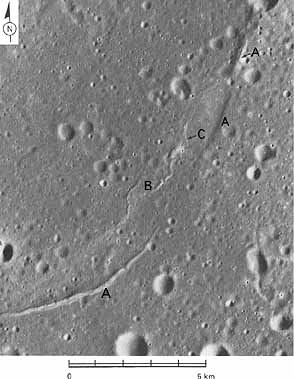 |
|
| |
|
FIGURE 84 [right].-This picture is included for several reasons. It is an example of a mare ridge on the far side of the Moon. It also shows that mare ridges occur in small bodies of mare. Finally, it serves as another example of a mare ridge transecting terra as well as mare. The scene covers part of the floor and eastern wall of Aitken, a large (135 km) crater near the center of the far side. The dark area is mare material, forming part of Aitken's floor. The ridge along the east edge of the mare fill extends southward (straight arrows) for a considerable distance beyond the edge of the picture, gradually ascending the east wall of Aitken. To the northwest (curved arrows) the same ridge extends for about 7 km diagonally along the north wall before disappearing. Whether in the mare or in the terra materials of the crater wall, the morphology and geometry of the ridge suggest that viscous material was squeezed out along a fault (?) plane that dips gently westward. The oval area patterned like a turtle shell is probably volcanic in origin. Other examples of this rather rare feature are shown in the chapter entitled "Unusual Features."-G.W.C. |
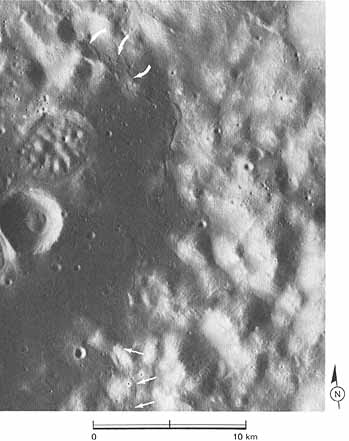 |
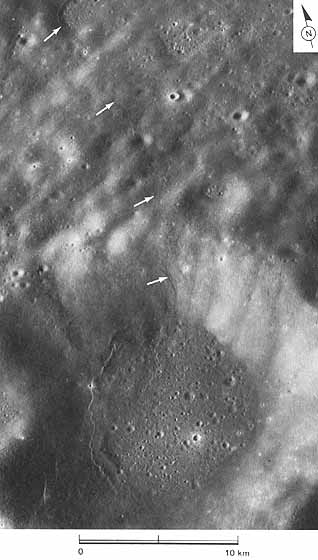 AS17-1676 (P) AS17-1676 (P) |
[94] FIGURE 85 [left].-In this unnamed crater on the far side we see ridges closely resembling those already described. Inasmuch as no mare materials are present here, the term "mare ridge" is not appropriate. The materials occupying most of the crater floor, while resembling mare, are plains deposits. Those along the western part of the floor and the lower part of the west wall probably consist of unconsolidated erosional debris from the wall. The crisp appearance of the ridges as they transect unconsolidated material proves that they are relatively young and that they are composed of resistant material. Here also the ridges may be related to faulting. The ridge nearest the center of the crater can be traced (arrows) part of the way up the north wall; interrupted segments are visible along the same trend northward to the edge of the picture. They may mark a steeply dipping fault plane.-G.W.C.
|
FIGURE 86 [below].-In this picture we see another example of the close relationship between mare ridges and faults. The area is in the Montes Riphaeus between Mare Cognitum and Oceanus Procellarum. A small part of Oceanus Procellarum is shown in the upper left. A mare ridge (MR) extends across Procellarum to the edge of the Montes Riphaeus. In all visible respects it is typical of a great many other mare ridges. Across the Montes Riphaeus (arrow to arrow) the trend of the ridge becomes a fault or series of faults causing the valley. Narrower valleys or grooves in the lower part of the picture are parallel to the larger valley and they too probably originated by faulting. Near the east edge of the picture the Montes Riphaeus are bounded by mare (M). Parts of the contact are quite angular (heavy lines), suggesting a series of offset faults, possibly continuations of the main mare ridge-fault trend.-G.W.C.
|
[95] |
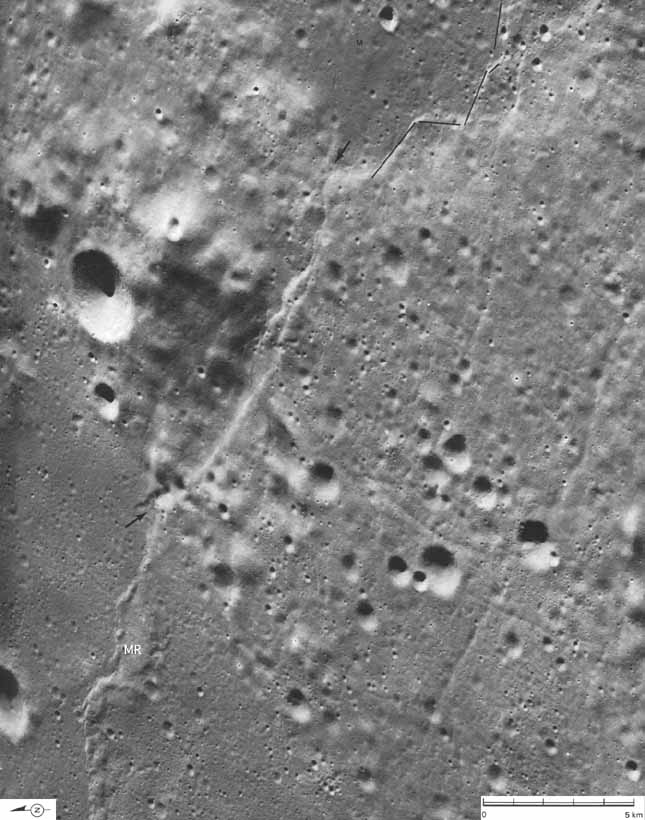 |
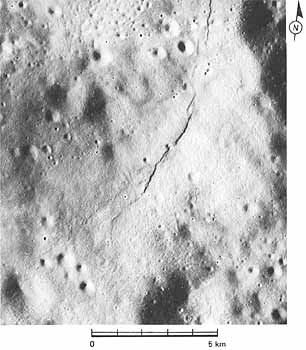 |
[96] FIGURE 87 [left].-This crenulate lobate scarp occurs within a small depression on the far side. It is not related to any obvious crater source, although it is similar to lobate flow fronts within the ejecta blankets of some young impact craters. Although it resembles some mare ridges, it is clearly confined to highlands terrane. Small scarps of this kind- unrelated to any apparent source of material or to any detectable tectonic control-are widely scattered in the highlands; their origin remains enigmatic. Mass wasting along a fault scarp might have produced the lobate configuration. A flow of locally derived surficial debris is also a plausible explanation; in this case, such a flow might have been triggered by small impacts on a ridge to the northwest.-C.A.H.
|
|
| |
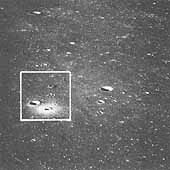 |
FIGURE 88 [left].-This is an oblique view of an area in Mare Nubium west of the central lunar highlands taken with the Hasselblad camera on Apollo 16. The small picture to the left is the entire frame reproduced slightly larger (112 percent) than the size of the original negative, and the larger picture on the facing page [below] is a 12.5X enlargement of the area outlined within the small picture. The view shows two distinct types of lunar craters in the mare. The two craters in the near field are typical of a great many small impact craters. The larger one has a raised hummocky rim but no bright ejecta blanket and no visible rays. The smaller and probably younger one to the right displays an extensive hummocky ejecta blanket and a system of bright, radial rays. The dark crater near the middle of the photograph has little in common with the first two. It has a prominent, smooth, convex rim. It is not surrounded by a hummocky or blocky ejecta blanket and has no rays. These characteristics suggest that this crater is volcanic in origin. Occurrences like this indicate that both impact and volcanic processes were active on the Moon, and that they are both responsible for crater formation. However, as one can see in this view, impact craters are more numerous. F.E.-B. |
|
[97]
|
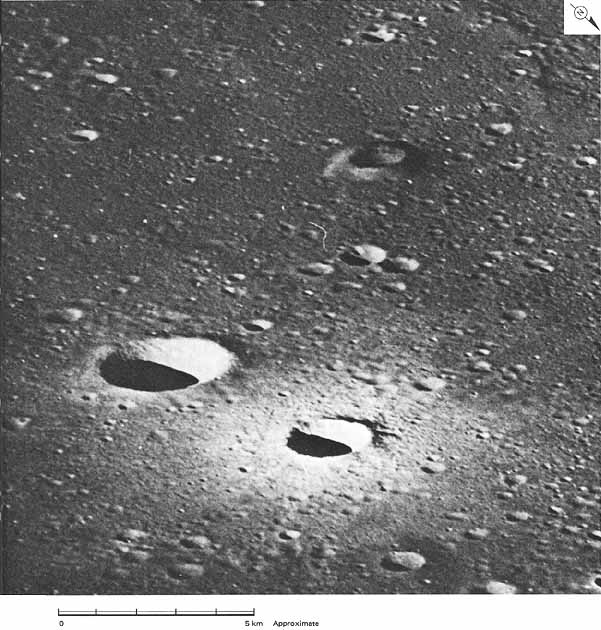 |
|
[98] |
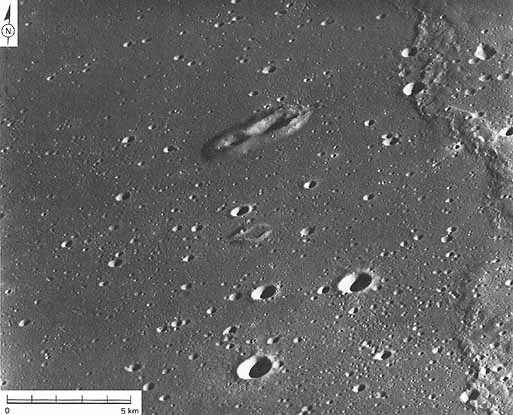 |
FIGURE 89 [above].-A few volcanic craters lie in a field of impact craters in Oceanus Procellarum, northwest of the Aristarchus plateau. Three in number, the volcanic structures are easily recognized by their high rims, planar slopes, and elongate shape. They are clearly embayed and partly buried by mare basalt, and thus are older than the mare plain surrounding them.-D.H.S.
FIGURE 90 [below].-This panoramic camera enlargement shows two small (2 km across volcanic cones (A and B) near the southeastern margin of Mare Serenitatis. They are intergradational with the surrounding mare basalt and probably are similar in age (about 3 billion years). The same cones can be seen in their regional context in figures 58 (lower right) and 60 (lower left). One cone (B) has an enclosed summit crater and the other (A) has a breached crater leading to a rillelike valley. Both conditions are common among volcanic cinder cones on Earth. The cones appear to be alined along the buried extension of a straight rifle (C), suggesting a relationship between volcanism and tectonism that is common on Earth. In size, appearance, and geologic setting these lunar cones are remarkably similar to terrestrial cinder cones; by analogy they are probably composed of interlayered fragmental material and lava flows. The elongate depressions marked D, as well as the straight and arcuate rilles, are probably of structural origin resulting from faulting and collapse along fractures.-D.H.S.
|
[99]
|
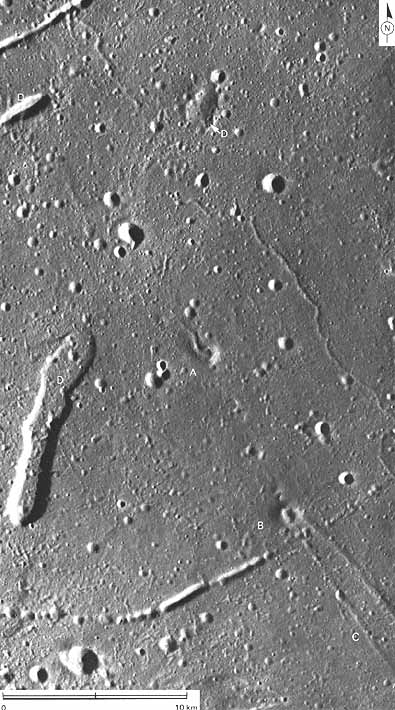 |
|
[100] |
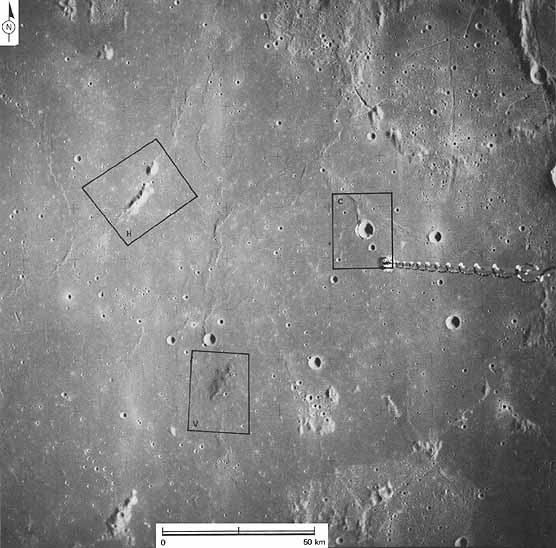 |
FIGURE 91 [above].-This picture of the eastern part of Mare Cognitum, while of interest in many respects, is used here largely to locate the dark hills (V) illustrated in detail in figure 92. Although small, the complex of dark hills is easily discernible because it is lower in albedo and is rougher than the surrounding mare lavas. Also included in this view are two bright hills (~ that were described earlier (fig. 69) as probably being of volcanic origin and an apparently faulted crater (C) that will be described later (fig. 246). Note the proximity of all three features to mare ridges. The dark hills lie within a westward bulge of one mare ridge, the two bright hills interrupt another ridge, and the crater is intersected by a third ridge. The association probably is not accidental.-M.C.M.
|
[101] FIGURE 92 [right].-The dark, rugged-surfaced complex of hills is enlarged many times in this stereogram. Without further detailed study, two explanations for its origin seem equally plausible. The complex may be a densely cratered block of terrae that was partly inundated by the lavas of Mare Cognitum and subsequently blanketed by dark volcanic ejecta. Within the darkened area, the concentration of fresh young craters is less than the surrounding mare surface, strongly suggesting that the dark blanketing was deposited appreciably later than the mare lavas. Alternatively, the complex may be a pile of lava flows densely pockmarked by volcanic craters, and, as in the first case, subsequently covered by volcanic ejecta. The steplike, but discontinuous ledges along the east side of the complex probably represent successive flows of viscous lava. All the craters are shallow, probably because they have been filled by their own ejecta or by that from nearby craters. Nevertheless, several craters (see arrows) have steep raised rims, distinguishing them from impact craters. The difference is clear at A where a volcanic crater (left) can be readily compared to a normal impact crater (right).-G.W.C.
|
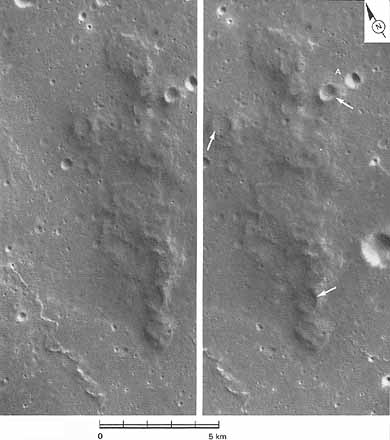 |
|
| |
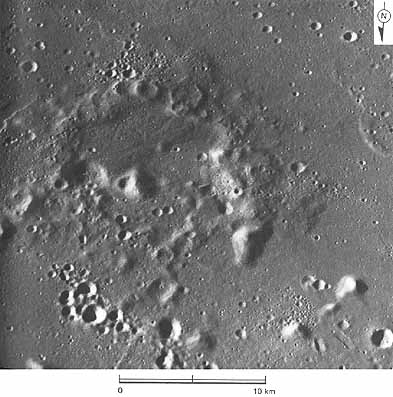 |
FIGURE 93 [left].-Easily identifiable volcanic complexes like the one in figure 92 are not common, but some others have been recognized. This crudely circular belt of high-rimmed craters is located along the common boundary between Oceanus Procellarum and Mare Imbrium, about 130 km southwest of the crater Euler. Here also, a cover of dark material-presumably volcanic ejecta-is present. However, unlike the previous example, which was surrounded by a "sea" of unbroken mare, this complex is closely associated with many peaks of premare terra. They are distinguished not only by their appreciable relief, but also by their smooth surfaces and lighter tone.-G.W.C.
|
|
[102] |
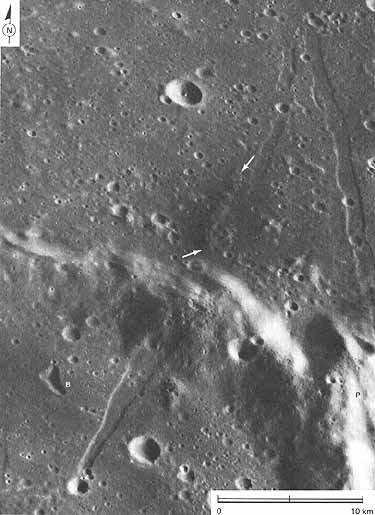 |
FIGURE 94 [above].-Patches of dark material-presumably volcanic ejecta-are commonly associated with straight rilles or grabens. This area is near the Apollo 14 landing site. (See fig. 44.) The prominent ridge separates the large ancient crater Fra Mauro in the north half of the scene from the smaller craters Bonpland (B) and Parry (P). The graben extending through the center of the picture cuts the floors of both Fra Mauro and Bonpland, as well as the intervening rim. Just north of the rim the graben has been completely filled and buried by dark materials. In appearance the low hills (see arrows) directly west of the graben resemble the volcanic complexes described in figures 92 and 93. The complexes are centered in the dark area and may well have been the source of the dark material. Starting with the formation of the three craters, the following events occurred: The craters were filled with mare lavas, the grabens were formed, and the dark volcanic materials were erupted. As everywhere else on the Moon, small bodies sporadically struck the surface throughout the entire interval of time.-G.W.C.
[103] FIGURE 95 [below].-Resembling a dome whose top has collapsed, this unusual structure (see large arrow) may be just that. It is located in the southeastern part of Mare Crisium, a large mare-filled circular basin near the Moon's east limb. The mare ridges shown are part of an extensive ridge system that encircles the floor of the basin. The broad circular depression occupying the center of the dome may be analogous to the calderas that occupy the center of many volcanic edifices on Earth. It may have formed as the pressure exerted on a mass of molten rock being forced upward toward the surface was released, allowing the overlying rocks to settle. A similar appearing but smaller dome with a summit depression occurs on the northwest flank (lower right side as this picture is oriented) of the larger one. Another large circular structure (see small arrow) may have formed in the same manner, but the evidence is less compelling. It can just as easily be interpreted as being the remnant of a lava-flooded impact crater that was later blanketed by the dark material covering much of the area shown here.-G.W.C.
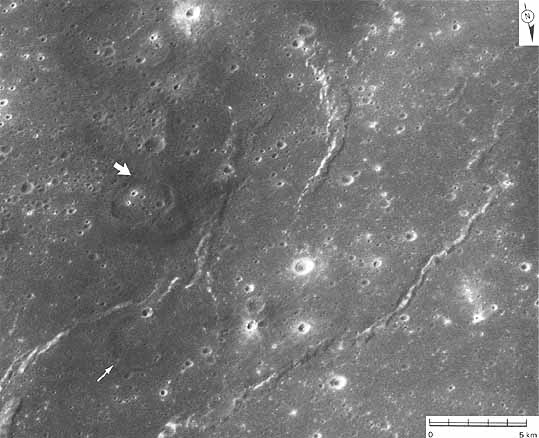
| Next |